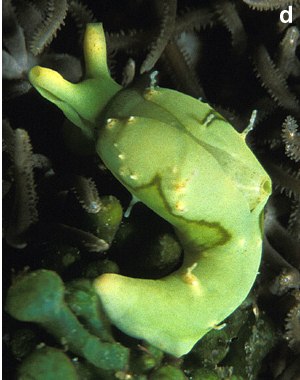Oxynoe kabirensis from Hachijo Island, Japan
April 29, 2002
From: Shouichi Kato

Dear Bill,
Please see attached 4 pictures. There are 3 animals from Hachijo Island, Japan, that I think are all variations of Oxynoe kabirensis. But as we can find so many variations, there is an opinion these are the variations of Oxynoe viridis.
I would like to know how we can identify these two species and if these three are all the same species. I always very much appreciate your advice.
Picture (a) (a and b found together)
size; 30mm depth; 3m
Picture (b)
size; 25mm depth; 3m
Picture (c) and (d) (same animal)
size; 30mm depth; 10m
Thanks and best regards,
S. Kato
regulus@edit.ne.jp


Dear Shouichi,
These all certainly fit Hamatani's description of Oxynoe kabirensis which fortunately included a description and illustrations of the living animal, and a comparison with Oxyemnoe viridis.
Hamatani notes some differences in the shape of the shell, and considers the radular teeth of O. kabirensis to be somewhat wider than the teeh of O. viridis, but the main difference is in the shape and colour of the living animal. The background colour of O. kabirensis varies from a pale yellowish green to a dark green, but whatever the color there is always a darker region at the base of the parapodia which extends up as a triangular peak in the middle of the parapodia. There can also be secondary peaks at the front and back of the parapodia. The edge of this darker patch is lined with an even darker line. There can be some yellowish spots on the parapodia and there are usually a few scattered very elongate papillae, which are probbaly retractile. In O. viridis the background colour is uniform, there being no darker green patch on the parapodia, and usually ther are scattered blue spots.
• Hamatani, I. (1980) On the species of the genus Oxynoe Rafinesque, 1819 from Japan, inclusive of a new species (Opisthobranchia: Ascoglossa). Publications of the Seto Marine Biological Laboratory, 25(5-6): 349-360.
Thanks very much for these photos, they are an interesting addition to Hamatani's original description.
Best wishes,
Bill Rudman
Related messages
-
Oxynoe kabirensis at Hachijo Island
From: Nishina Masayoshi, May 11, 2002 -
Colour camouflage in Oxynoe kabirensis
From: Nishina Masayoshi, May 11, 2002
